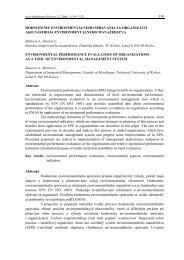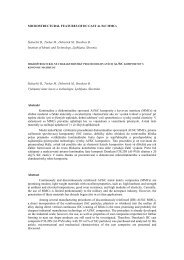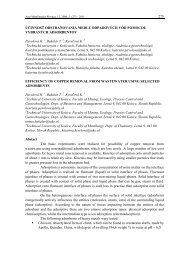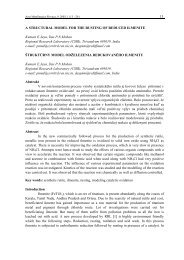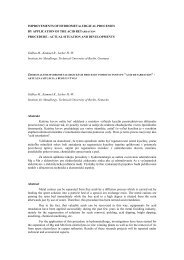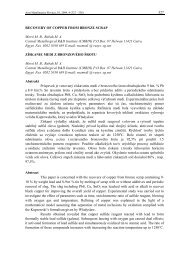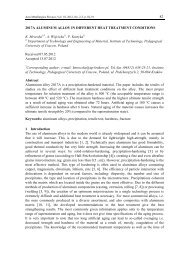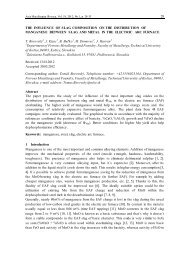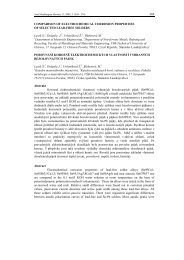TEMPERATURE MEASUREMENT DURING COLD TENSILE TEST
TEMPERATURE MEASUREMENT DURING COLD TENSILE TEST
TEMPERATURE MEASUREMENT DURING COLD TENSILE TEST
You also want an ePaper? Increase the reach of your titles
YUMPU automatically turns print PDFs into web optimized ePapers that Google loves.
Acta Metallurgica Slovaca, 10, 2004, 3 (230 - 235) 230<br />
<strong>TEMPERATURE</strong> <strong>MEASUREMENT</strong> <strong>DURING</strong> <strong>COLD</strong> <strong>TENSILE</strong> <strong>TEST</strong><br />
Tomčík P., Kulhánek J., Švrčková R., Hrubý J.<br />
VŠB–Technical University of Ostrava, Faculty of Mechanical Engineering, Department of<br />
Mechanical Engineering Technology, Department of control systems and instrumentation,<br />
17. listopadu 15, 708 33 Ostrava – Poruba, CZ<br />
MĚŘENÍ TEPLOTY V PRŮBĚHU TAHOVÉ ZKOUŠKY<br />
Tomčík P., Kulhánek J., Švrčková R., Hrubý J.<br />
VŠB–Technická universita Ostrava, Fakulta strojní, katedra mechanické technologie, Katedra<br />
automatizační techniky a řízení, 17. listopadu , 70833 Ostrava–Poruba, ČR<br />
Abstrakt<br />
V tomto příspěvku je popisováno měření teploty při tahové zkoušce. Ke změně<br />
teploty povrchu zkušebního vzorku dochází v důsledku adiabatického ohřevu. Měření teploty<br />
bylo provedeno pomocí termočlánků. Na povrchu zkušebního vzorku pro zkoušku tahem bylo<br />
přivařeno pět termočlánků, které pomocí kompenzačního vedení a zakončovacího panelu byly<br />
připojeny k měřící kartě.<br />
Abstract<br />
The measuring of the temperature of the surface sample for tensile test is described in<br />
this paper. The measuring of the temperature was made with thermocouples. Increase<br />
temperature during tensile test is produced adiabatic heating. Five thermocouples were welded<br />
on the surface sample. The thermocouples were connected in terms of compensatory leads to a<br />
daughter board and then to a data acquisition board.<br />
Key words:Flow stress, strain, adiabatic heating, thermocouple, strain rate<br />
Introduction<br />
During plastic deformation the flow stress is influenced with a strain rate, attained<br />
strain and with the temperature. We wanted to determine an evolution of the temperature during<br />
tensile test. For a stable plastic flow is necessary energy supplier. About 95-98% from this<br />
energy is changed into heating - adiabatic heating. The<br />
adiabatic heating causes decrease of the flow stress. This<br />
process is strain rate – dependent. The decrease of the flow<br />
stress can cause localization of the plastic flow. If the<br />
decrease of the flow stress is in the local material volume,<br />
then it causes localization of plastic flow - it is increase strain<br />
and it causes the increase of temperature, the loop runs again<br />
(Fig. 1.).<br />
Fig.1 Localization of the plastic flow<br />
Experiment<br />
Measuring set<br />
For the high-speed temperature measuring, was chosen the thermocouples with a<br />
short response time. Typically the data acquisition cards (DAC) for thermocouples don’t allow
Acta Metallurgica Slovaca, 10, 2004, 3 (230 - 235) 231<br />
high speed data acquisition. Because of that, we chose the universal DAC with 330 kHz AD<br />
converter and high gain (1000x) suitable for thermocouples. Measuring set consists of following<br />
hardware (Fig. 2):<br />
• Personal computer with Windows 98 operating system<br />
• Data acquisition card ICP-DAS 1800H (at Fig. 4)<br />
• Daughter board ICP-DAS DB 8225/2 (at Fig. 5)<br />
• Set of thermocouples type K and extension wires.<br />
PC with<br />
DAC 1802H<br />
2m cable to<br />
daughter board<br />
Thermocouples<br />
(type K)<br />
F<br />
loading force<br />
Daughter board<br />
DB-8225 with CJC<br />
Thermocouple<br />
extension wires<br />
(type K)<br />
Test sample<br />
Fig.2 Measuring set<br />
With the DAC was supplied a basic communication software and drivers. For the<br />
measuring we have to create own measuring software with following features:<br />
• Architecture is Visual Basic application with card developer supplied DLL functions.<br />
• Interactive setting and reading of eight AD inputs in differential mode.<br />
• Interactive setting type of data to voltage or temperature (thermocouples type K).<br />
• Interactive setting of measuring frequency (with recommendation of freq. limits).<br />
• Interactive setting of number of samples for digital filtration.<br />
• Continuous data acquisition for selected channels, selected frequency and selected time.<br />
• Output file format suitable for MS Excel import.<br />
The interactive window of created measuring software is on Fig. 3.<br />
Fig.3 Interactive setting window
Acta Metallurgica Slovaca, 10, 2004, 3 (230 - 235) 232<br />
Universal data acquisition card used for measurement was following important<br />
parameters:<br />
• D/A converter with 330 kHz sample frequency and 12bits resolution.<br />
• Adjustable gain in range (0.5, 1, 5, 10, 50, 100, 500, 1000).<br />
• Multiplexed 16 single ended inputs, or 8 differential inputs (used for thermocouples).<br />
• Internal FIFO memory buffer (1024 samples) for uninterrupted continuous data<br />
acquisition.<br />
• Three internal timers with adjustable sampling frequency for accurate data input<br />
sampling.<br />
• Two independent D/A converters with 12bits resolution and output range ±5V or ±10V.<br />
• 16 digital inputs and 16 digital outputs.<br />
Fig.4 Data acquisition card<br />
For using in laboratory research is important flexibility and facility of mounting<br />
inputs [1]. Because of that, we have acquired the daughter board DB-8225/2 with following<br />
important features:<br />
• The cable (2 meters long) for connection with DAC ICP-DAS 1800H.<br />
• On board terminal block (set of clips with screws) for easy inputs and outputs<br />
mounting.<br />
• On board integrated temperature sensor for Cold Junction Compensation (for<br />
thermocouples inputs). The CJC sensor can be enabled or disabled for input channel 0.<br />
Fig.5 Daughter board
Acta Metallurgica Slovaca, 10, 2004, 3 (230 - 235) 233<br />
The preparation of test sample and condition of the experiment<br />
The test sample was made from the steel 12013. Steel 12013 is ferritic steel with<br />
small quantity pearlite [2]. The steel 12013 has guaranteed magnetic properties. Geometrical<br />
form of the sample is at Fig. 7. On the cylinder part of the sample were cut scale lines. At the<br />
beginning of the tensile test the distance between scale lines was 10mm. In the half 10mm height<br />
of this cylinder – segment the thermocouple was welded with a capacitor welder TCW 3<br />
(Fig.6.). The strain rate was 0,083S -1 . Then the test sample with welded thermocouples was<br />
loaded tensile force until fracture. During this tensile test we measured evolution of the<br />
temperature.<br />
Fig.6 Welding of thermocouple<br />
Fig.7 Arrangement of the thermocouples on the surface of the sample<br />
Results<br />
The output from our experiment was evolution temperature in dependency on time.<br />
The evolution temperature is produced by adiabatic heating. The form of the sample after the<br />
tensile test is in Fig. 8. We made measuring in five segments. In the centre of each segment was<br />
thermocouple. From each thermocouple we obtained a curve of temperature evolution<br />
(at Fig.9 ).<br />
Fig.8 Test sample after tensile test
Acta Metallurgica Slovaca, 10, 2004, 3 (230 - 235) 234<br />
100<br />
90<br />
4<br />
The fracture occurred in the time t=8,312s<br />
80<br />
Temperature (°C)<br />
70<br />
60<br />
50<br />
3<br />
2<br />
40<br />
30<br />
5<br />
1<br />
20<br />
0 2 4 6 8 10 12 14 16 18 20<br />
time (s)<br />
Fig.9 Evolutions temperatures were measured with five thermocouples<br />
It is evident (from fig. 8-9), that in the segment where the fracture was, the<br />
thermocouple measured maximum of the temperature. On the curves of evolution temperature<br />
we can see, that neighbouring segments (number 5 and number 3) with regard to fracture<br />
segment (number 4) are warmed with the heat from the fracture segment. That is why on curves<br />
number 3 and number 5 are two maximums of the temperature. The curves number 5 is shift to<br />
less values of the temperature. It is caused position of the segment number 5 at sample. The<br />
segment number 5 is near by stepped part of the greater diameter.<br />
We can see distribution isotherms on the surface of the sample in dependency on the<br />
time (On the fig. 10.) During the time is realized heat balance with the transport heat from warm<br />
region into cold region. Distribution of the ductility in dependency on the position on the sample<br />
is at Fig. 11. The fracture segment (number 4) was got the maximum of the ductility. The<br />
thermocouple number 1 was welded with cold joint. Because of that we can not observe change<br />
of the temperature.
Acta Metallurgica Slovaca, 10, 2004, 3 (230 - 235) 235<br />
Fig.10 Distribution of isotherms on the surface of the sample in dependency on time.<br />
The distribution of ductility after test<br />
100<br />
90<br />
4<br />
80<br />
70<br />
ductility (%)<br />
60<br />
50<br />
40<br />
30<br />
20<br />
1<br />
2<br />
3<br />
5<br />
10<br />
0<br />
Fig.11 Distribution of the ductility along the sample<br />
Conclusion<br />
The measuring of the temperature was made with thermocouples. Made experiment<br />
demonstrated, that our designed measuring set is able to measured evolution of the temperature<br />
during the tensile test. The measuring results are according to known model of behaviour of the<br />
material. The measuring set makes possible monitor change of the temperature which is caused<br />
with plastic strain.<br />
Acknowledgement<br />
Project was realized with the financial support of the Grant Agency of the Czech<br />
Republic registration number 101/04/P104.<br />
Literature<br />
[1] ICP DAS, PCI 1800 Hardware User’s Manual, Taiwan: Hsinchu, 2001, 100p.
Acta Metallurgica Slovaca, 10, 2004, 3 (230 - 235) 236<br />
[2] Tomčík P., Švrčková R., Hrubý J.: Comparison flow stress curve of the tension test of the<br />
steel 12013 in magnetic field, In: 12. mezinárodní vědecké konference CO-MAT-TECH<br />
2004 Zborník abstraktov. Bratislava: STU, 2004, s. 209. ISBN 80-227-2121-2



